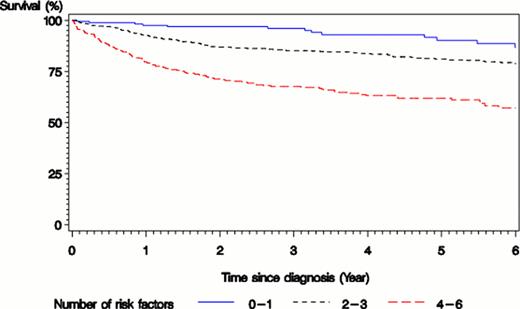Abstract
Abstract 3651
Diffuse large B-cell lymphoma (DLBCL) is the most common type of lymphoma accounting for 35–40%. Since the 1990s, The International Prognostic Index (IPI) has served as useful tool in daily treatment decision algorithm and in the design of clinical trials.
In the last decade, improvement of overall survival (OS) has been demonstrated with R-CHOP-like regimens. In addition, the median life expectancy has increased substantially since the 1980'ies and more intensive treatment options like autologous BMT are performed successful up to 70 years of age. Thus, prognostic factors, including age, are susceptible to change over time.
Patients with DLBCL diagnosed in the period 2000–2010 treated with Rituximab and CHOP-like chemotherapy were extracted from the Danish population-based Lymphoma Registry that covers > 97% of Danish lymphoma patients. Clinical and laboratory data at time of diagnosis were analysed, leaving out factors with < 75% completeness. Patients with transformed lymphoma, CNS involvement and HIV+ patients were excluded from the analysis.
1990 patients (M:F ratio 1.26) were extracted from the LYFO database. The median age was 65 years, median follow-up was 54 months. Overall median survival was 9.7 years, with a 5 year OS of 65%. Analysis of age using 60, 65, 70, 75 years as cut-off, revealed 70 years as the optimal cut-point.
Univariate analysis was performed including age, gender, stage, performance status, extranodal disease, LDH, albumin, immunoglobulin G, bulky disease, lymphocytes and haemoglobin. Only significant factors were included in a Cox proportional hazards model. Results for the entire patient cohort are shown in table I, and for patients <= 70 years in Table II.
All patients
| Variable . | Hazard ratio . | P . |
|---|---|---|
| Age 70/70+ | 3,22 | <0.0001 |
| Performance 0–1/2–4 | 2,2 | <0.0001 |
| LDH (elevated) | 1,48 | <0.0001 |
| Albumin (<40g/l) | 1,56 | <0.0001 |
| IgG <6 g/l | 1,41 | 0,005 |
| Stage (I-II/III-IV) | 1,25 | 0,03 |
| Variable . | Hazard ratio . | P . |
|---|---|---|
| Age 70/70+ | 3,22 | <0.0001 |
| Performance 0–1/2–4 | 2,2 | <0.0001 |
| LDH (elevated) | 1,48 | <0.0001 |
| Albumin (<40g/l) | 1,56 | <0.0001 |
| IgG <6 g/l | 1,41 | 0,005 |
| Stage (I-II/III-IV) | 1,25 | 0,03 |
Age adjusted (<= 70 years)
| Variable . | Hazard ratio . | P . |
|---|---|---|
| Performance 0–1/2–4 | 2,2 | <0.0001 |
| LDH (elevated) | 1,85 | <0.0001 |
| Albumin (<40g/l) | 1,93 | <0.0001 |
| Extranodal (>1) | 1,49 | 0,009 |
| IgG <6 g/l | 1,52 | 0,01 |
| Gender (M/F) | 1,36 | 0,02 |
| Variable . | Hazard ratio . | P . |
|---|---|---|
| Performance 0–1/2–4 | 2,2 | <0.0001 |
| LDH (elevated) | 1,85 | <0.0001 |
| Albumin (<40g/l) | 1,93 | <0.0001 |
| Extranodal (>1) | 1,49 | 0,009 |
| IgG <6 g/l | 1,52 | 0,01 |
| Gender (M/F) | 1,36 | 0,02 |
Survival analysis of patients with 0–1, 2–3 and 4–6 risk factors showed 5-year survival values of 90%, 71% and 45% respectively (left figure). For patients <= 70 years, the corresponding values were 90%, 81% and 62%, respectively (right figure).
Two decades after the introduction of the IPI, age, performance status and LDH are still some of the most powerful prognostic factors in DLBCL. Age cut-off at 70 years is meaningful in reflecting clinical practice and, in our analysis, albumin and IgG added significant prognostic importance. In addition, for patients younger than 70 years, male gender is an adverse prognostic factor.
No relevant conflicts of interest to declare.
Author notes
Asterisk with author names denotes non-ASH members.



This feature is available to Subscribers Only
Sign In or Create an Account Close Modal